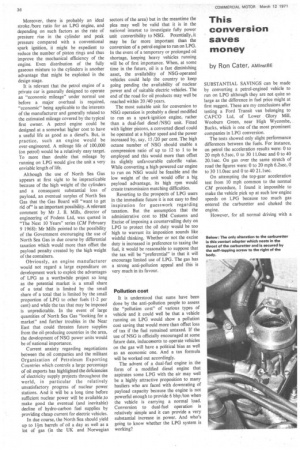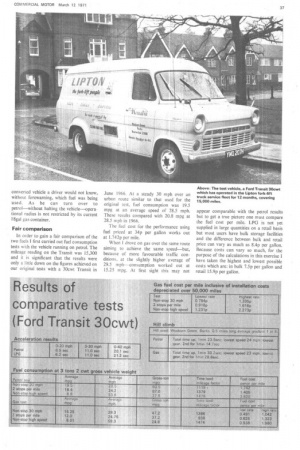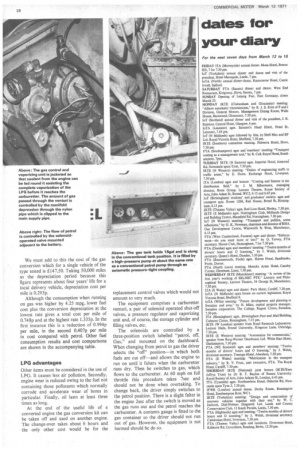This conversion saves money
Page 38

Page 39

Page 40

If you've noticed an error in this article please click here to report it so we can fix it.
by Ron Cater, AMInstBE
SUBSTANTIAL SAVINGS can be made by converting a petrol-engined vehicle to run on LPG although they are not quite so large as the difference in fuel price might at first suggest. These are my conclusions after testing a Ford Transit van belonging to CAFCO Ltd, of Lower Glory Mill, Wooburn Green, near High Wycombe, Bucks, which is one of the most prominent companies in LPG conversion.
The tests showed only slight performance differences between the fuels. For instance, on petrol the acceleration results were: 0 to 20 mph 6.5sec, 0 to 30 11.0sec and 0 to 40 20. [sec. On gas over the same stretch of road the figures were: 0 to 20 mph 6.2sec, 0 to 30 11.0sec and 0 to 40 21.1sec.
On attempting the top-gear acceleration test from 10 mph common to the normal CM procedure, I found it impossible to make the vehicle pick up at such low engine speeds on LPG because too much gas entered the carburetter and choked the engine.
However, for all normal driving with a converted vehicle a driver would not know, without forewarning, which fuel was being used. As he can turn over to petrol—without halting the vehicle—operational radius is not restricted by its current 18gal gas container.
Fair comparison In order to gain a fair comparison of the two fuels 1 first carried out fuel consumption tests with the vehicle running on petrol. The mileage reading on the Transit was 15,300 and it is significant that the results were only a little down on the figures achieved on our original tests with a 30cwt Transit in June 1966. At a steady 30 mph over an urban route similar to that used for the original test, fuel consumption was 19.5 mpg at an average speed of 28.5 mph. These results compared with 20.8 mpg at 28.5 mph in 1966.
The fuel cost for the performance using fuel priced at 34p per gallon works out at 1.742p per mile.
When 1 drove on gas over the same route aiming to achieve the same speed—but, because of more favourable traffic conditions, at the slightly higher average of 29.5 mph—consumption worked out at 15.25 mpg. At first sight this may not appear comparable with the petrol results but to get a true picture one must compare the fuel cost per mile. LPG is not yet supplied in large quantities on a retail basis but most users have bulk storage facilities and the difference between bulk and retail price can vary as much as 8.4p per gallon. Because costs can vary so much, for the purpose of the calculations in this exercise I have taken the highest and lowest possible costs which are: in bulk 7.5p per gallon and retail 15.9p per gallon. We must add to this the cost of the gas conversion which for a single vehicle of the type tested is £.147.50. Taking 50,000 miles as the depreciation period because this figure represents about four years' life for a local delivery vehicle, depreciation cost per mile is 0.293p.
Although the consumption when running on gas was higher by 4.25 mpg, lower fuel cost plus the conversion depreciation at the lowest rate gives a total cost per mile of 0.748p and at the highest rate 1.335p. In the first instance this is a reduction of 0.994p per mile, in the second 0.407p per mile in cost compared with petrol. Other fuel consumption results and cost comparisons are shown in the accompanying table.
LPG advantages Other items must be considered in the use of LPG. It causes less air pollution. Secondly, engine wear is reduced owing to the fuel not containing those pollutants which normally corrode and accelerate wear of bores in particular. Finally, oil lasts at least three times as long.
At the end of the useful life of a converted engine the gas conversion kit can be taken off and used on another engine. The change-over takes about 6 hours and the only other cost would be for the replacement control valves which would not amount to very much.
The equipment comprises a carburetter venturi, a pair of solenoid operated shut-off valves, a pressure regulator and vaporizing unit and, of course, the storage cylinder and filling valves, etc.
The solenoids are controlled by a three-position switch labelled "petrol, off, Gas," and mounted on the dashboard. When changing from petrol to gas the driver selects the "off" position-in which both
fuels are cut off and allows the engine to run on until it falters when the carburetter runs dry. Then he switches to gas, which flows to the carburetter. At 60 mph on full throttle this procedure takes 7sec and should not be done when overtaking. To change back, the driver simply switches to the petrol position. There is a slight falter in the engine 2sec after the switch is moved as the gas runs out and the petrol reaches the carburetter. A contents gauge is fitted to the gas container so the driver should not run out of gas. However, the equipment is not harmed should he do so.






















































































